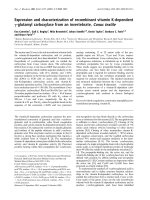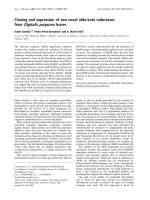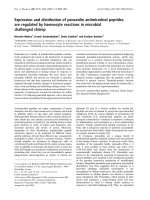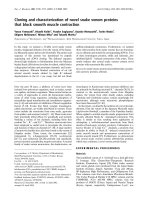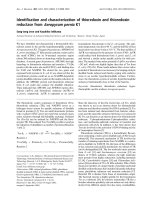Báo cáo y học: " Recruitment and retention of lung volume" doc
Bạn đang xem bản rút gọn của tài liệu. Xem và tải ngay bản đầy đủ của tài liệu tại đây (32.34 KB, 2 trang )
9
ARDS = acute respiratory distress syndrome.
Available online />One of the most common procedures performed in
mechanically ventilated patients is that of endotracheal
suctioning. Although most health care workers are aware of
the potential risks associated with this procedure, including
hypoxaemia and haemodynamic compromise, the potential
effects on the pathophysiology of the injured lung are not
usually highlighted. The recent literature on the mechanical
ventilation of patients with acute respiratory distress
syndrome (ARDS) stresses the importance of opening and
maintaining the patency of lung units in order to prevent
ventilator-associated lung injury. The report from Dyhr and
coworkers [1] in the present issue provides an important
practical insight into the de-recruitment caused by
endotracheal suctioning, and the value of the lung
recruitment manoeuvre in reversing these effects.
Since it became generally accepted that high tidal volumes
and inflation pressures are injurious to the lungs [2], clinical
trials in mechanical ventilation have emphasized pressure and
volume limitation [3,4]. However, a potential adverse effect of
reduced tidal volume ventilation is loss of functional lung
volume, with progressive atelectasis occurring over time [5].
This de-recruitment of lung not only exacerbates hypoxaemia
but may also produce further alveolar damage [6]. In fact, it
has been demonstrated that the repetitive opening and
closing of alveoli that occurs during tidal ventilation may
produce local inflammation, as well as the systemic release of
cytokines in the blood, potentially producing multiorgan
failure [7].
In the light of these effects of tidal volume limitation, an ‘open
lung’ strategy for mechanical ventilation has been advocated
in ARDS [8] to improve hypoxaemia and reduce ventilator-
induced lung injury. Recruitment of the lung occurs during
tidal ventilation, and sufficient positive end-expiratory
pressure can be used to counterbalance the tendency for the
alveoli to close. However, not all alveoli are recruited during
tidal ventilation in the injured lung because of surface tension
and adhesive forces, and higher pressures are needed to
reopen collapsed airways [9]. Methods used to recruit the
lung include sustained inflation manoeuvres, sighs, high-
frequency oscillation and prone positioning [10,11]. A clinical
trial of an ‘open lung’ approach in patients with ARDS
demonstrated a benefit over a ‘conventional’ ventilatory
strategy that did not employ pressure limitation or lung
volume recruitment [12].
The sustained inflation lung recruitment manoeuvre is a
relatively simple and safe intervention for achieving lung
volume recruitment [13]. Not all patients with ARDS
demonstrate a recruitment response; those at an earlier
stage in their disease and with normal chest wall mechanics
Commentary
Recruitment and retention of lung volume
Stephen E Lapinsky
Associate Director, Intensive Care Unit, Mount Sinai Hospital & Interdisciplinary Division of Critical Care, University of Toronto, Toronto, Ontario, Canada
Correspondence: Stephen E Lapinsky,
Published online: 18 December 2002 Critical Care 2003, 7:9-10 (DOI 10.1186/cc1857)
This article is online at />© 2003 BioMed Central Ltd (Print ISSN 1364-8535; Online ISSN 1466-609X)
Abstract
Both a reduction in tidal volume and in alveolar recruitment may be necessary to prevent ventilator-
induced lung injury in the management of patients with acute respiratory distress syndrome. The lung
collapse associated with endotracheal suctioning produces hypoxaemia, but it also causes de-
recruitment, potentially aggravating lung injury. A study conducted by Dyhr and colleagues
demonstrates the benefit of lung recruitment manoeuvres after suctioning, which help to improve
oxygenation and restore lung volume more rapidly. Although this intervention appears safe and
beneficial, the precise role of lung volume recruitment manoeuvres remains to be elucidated.
Keywords acute respiratory distress syndrome, atelectasis, mechanical ventilation, suctioning
10
Critical Care February 2003 Vol 7 No 1 Lapinsky
derive most benefit [14]. Furthermore, the degree of
‘recruitable’ lung may vary with disease state. Although the
patient with pneumonic consolidation may meet clinical
criteria for ARDS (bilateral infiltrates and hypoxaemia), the
pathophysiologies of the two states clearly differ. The loss of
alveoli in pneumonia is due to consolidation rather than
atelectasis from surfactant loss, and is less likely to be
recruitable [11].
The small randomized controlled study conducted by Dyhr
and colleagues provides clinical evidence of the significant
loss of lung volume after endotracheal suctioning and the
beneficial effect of a sustained inflation recruitment
manoeuvre [1]. The eight patients studied had moderately
severe ARDS (lung injury score 2.3–3.3) and were studied
early in the course of their disease (they had been ventilated
for <7 days). Half of the patients had a ‘primary’ cause of
ARDS (i.e. pneumonia), which may be less responsive to
recruitment attempts. Nevertheless, in the group as a whole
the manoeuvre was effective in improving oxygenation, lung
volume and respiratory system compliance more rapidly than
did tidal ventilation and positive end-expiratory pressure
alone. Lung recruitment following suctioning appears to be a
more physiologically appropriate intervention than the usual
approach of providing 100% oxygen during the procedure. In
fact, this high inspired oxygen concentration may be counter-
productive, tending to produce absorption atelectasis [15].
Although lung volume recruitment manoeuvres have a role to
play in ventilatory management of patients with ARDS, this
cannot be extrapolated to patients with other lung conditions.
Many questions related to this intervention remain
unanswered. Do recruitment manoeuvres actually open
previously closed lung units? What is the optimal method
and frequency for recruitment? Does this intervention
improve outcome? A multicentre Canadian randomized
clinical trial comparing a pressure limited strategy with and
without an ‘open lung’ approach is currently in progress. The
‘open lung’ protocol includes lung recruitment manoeuvres
after endotracheal suctioning and ventilator disconnects [16].
With this and other studies, the precise value of this
intervention may become more clearly defined over the next
few years.
Competing interests
None.
References
1. Dyhr T, Bonde J, Larsson A: Lung recruitment maneuvers are
effective to regain lung volume and oxygenation after open
endotracheal suctioning in acute respiratory distress syn-
drome. Crit Care 2003, 7:55-62.
2. Slutsky AS: Mechanical ventilation. American College of Chest
Physicians’ Consensus. Chest 1993, 104:1833-1859.
3. Stewart TE, Meade MO, Cook DJ, Granton JT, Hodder RV, Lapin-
sky SE, Mazer CD, McLean RF, Rogovein TE, Schouten BD, Todd
TR, Slutsky AS: Evaluation of a ventilation strategy to prevent
barotrauma in patients at high risk for acute respiratory dis-
tress syndrome. N Engl J Med 1998, 338:355-361.
4. The Acute Respiratory Distress Syndrome Network: Ventilation
with lower tidal volumes as compared with traditional tidal
volumes for acute lung injury and the acute respiratory dis-
tress syndrome. N Engl J Med 2000, 342:1301-1308.
5. Richard JC, Maggiore SM, Jonson B, Mancebo J, Lemaire F,
Brochard L: Influence of tidal volume on alveolar recruitment.
Respective role of PEEP and a recruitment maneuver. Am J
Respir Crit Care Med 2001, 163:1609-1613.
6. Muscedere JG, Mullen JB, Gan K, Slutsky AS: Tidal ventilation at
low airway pressures can augment lung injury. Am J Respir
Crit Care Med 1994, 149:1327-1334.
7. Ranieri VM, Suter PM, Tortorella C, De Tullio R, Dayer JM, Brienza
A, Bruno F, Slutsky AS: Effect of mechanical ventilation on
inflammatory mediators in patients with acute respiratory dis-
tress syndrome: a randomized controlled trial. JAMA 1999,
282:54-61.
8. Lachmann B: Open up the lung and keep the lung open. Inten-
sive Care Med 1992, 18:319-321.
9. Crotti S, Mascheroni D, Caironi P, Pelosi P, Ronzoni G, Mondino
M, Marini JJ, Gattinoni L: Recruitment and derecruitment during
acute respiratory failure. Am J Respir Crit Care Med 2001, 164:
131-140.
10. Mehta S: Lung volume recruitment. Curr Opin Crit Care 1998,
4:6-15.
11. Pelosi P, Cadringher P, Bottino N, Panigada M, Carrieri F, Riva E,
LIssoni A, Gattinoni L: Sigh in acute respiratory distress syn-
drome. Am J Respir Crit Care Med 1999, 159:872-880.
12. Amato MBP, Barbas CSV, Medeiros DM, Magaldi RB, Schettino
GB, Lorenzi-Filho G, Kairalla RA, Deheinzelin D, Munoz C, Oliveira
R, Takagaki TY, Carvalho CR: Effect of a protective-ventilation
strategy on mortality in the acute respiratory distress syn-
drome. N Engl J Med 1998, 338:347-354.
13. Lapinsky SE, Aubin M, Mehta S, Boiteau P, Slutsky AS: Safety
and efficacy of a sustained inflation for alveolar recruitment in
adults with respiratory failure. Intensive Care Med 1999, 25:
1297-1301.
14. Grasso S, Mascia L, Del Turco M, Malacarne P, Giunta F,
Brochard L, Slutsky AS, Ranieri M: Effects of recruiting maneu-
vers in patients with acute respiratory distress syndrome ven-
tilated with protective strategy. Anesthesiology 2002, 96:
795-802.
15. Rothen HU, Sporre B, Engberg G, Wegenius G, Hogman M,
Hedenstierna G: Influence of gas composition on recurrence
of atelectasis after a reexpansion manoeuvre. Anesthesiology
1995, 82:832-842.
16. Stewart TE, Meade MO, Slutsky AS, Hand L, Ronco J, Chittock D,
Evans D, Hodder R, Griffith L, Graham J, Lessard M, Magder S,
Laporta D: Complications of a lung recruitment maneuver
[abstract]. Am J Respir Crit Care Med 2002, 165:A682.





